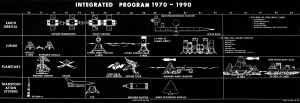Manned Mars Landing by Wernher von Braun Pt 6
From The Space Library
Contents |
MAJOR SCHEDULE MILESTONES
Major Schedule Milestones 1982 Mars Landing
1982 MANNED MARS LANDING
The development schedule for the 1982 Manned Mars Landing culminates with the December 1981 Earth departure. The five major hardware elements required are shown. The Nuclear Shuttle, Space Shuttle and the mission module are required to carry out the planned pro¬gram for the 1970’s. The Mars Excursion Module and the Mars Surface Sample Return Probe are needed exclusively for this landing mission.
"Go ahead" dates refer to the start of a hardware development program and "1st flight" indicates the first test flight of the system. Sufficient test time has been included to allow an earth orbital practice mission because of the long mission duration and the infrequency of Mars mission opportunities.
The option to make the 1982 Mars Landing can be kept open until 1974 (Mars Excursion Module go ahead) provided the Nuclear Shuttle, the Space Shuttle, and the Common Mission Module are designed to be responsive to the ultimate requirements of the Mars Landing Mission.
INTEGRATED PROGRAM LOGIC
In order to accomplish the Integrated Space Program for the funding shown, it was necessary to develop an integrated program logic. This logic required maximum use of Apollo systems, multi mission application of common modules, and the intro¬duction of reusable transportation systems. The application of the logic in formulating this Integrated Program made it economically feasible.
The long duration manned planetary missions will be made possible by the operational experience gained and the systems developed for the Integrated Program in the 1970's. The Earth orbital program will qualify both man and systems for long duration while the lunar program will provide techniques and experience for surface operations. The automated precursor missions provide Mars atmospheric and surface characteristics necessary to design and develop mission peculiar systems. In order to accomplish this high energy mission, it will be necessary to augment the chemical propulsion systems with a more efficient nuclear system.
With the systems developed and the experience gained from the early Mars mission, it will be possible to evolve to a temporary base by the end of the decade of the eighties if early explorations prove interesting.
- MAXIMUM USE OF APOLLO SYSTEMS
- APPLICATION OF COMMON MISSION MODULES
- DEVELOPMENT OF REUSABLE TRANSPORTATION SYSTEMS
- EARTH ORBIT DEMONSTRATION OF MANNED LONG LIFE SYSTEMS
- LUNAR SURFACE ACTIVITY AS PREPARATION FOR MARS SURFACE OPERATIONS
- UTILIZATION OF AUTOMATED PRECURSORS
- ADD NUCLEAR PROPULSION TO CHEMICAL PROPULSION FOR DEEP SPACE OPERATIONS
EVOLUTION TO MARS BASE
INTEGRATED PROGRAM 1970 1990
The application of the described logic results in the program shown on the next 2 charts. This chart depicts the integrated program for the 1970's already submitted to the Space Task Group. The next chart represents the logical extension of this program including the Manned Mars Landing Mission.
Maximum utilization of Apollo systems in the early 1970's is demonstrated by the use of two Saturn V Workshops in Earth orbit and additional Apollo type missions for further lunar exploration. The Saturn V vehicle is used to launch these missions. The Apollo systems are shown in blue.
Integrated Program 1970-1990
Three new systems are required during the 1970's to provide the commonality and reusability necessary to increase the capabilities in the last half of the decade. The systems are a new mission module (green), a space shuttle (red) and the tug (yellow). Two mission modules are integrated to serve as a space station in Earth orbit until the end of the decade. This same basic mission module is used in lunar orbit and as a lunar surface base.
The space shuttle is the key element to future space operations. It is used to trans¬port people, equipment, and supplies to Earth orbit in support of all subsequent missions.
The space tug is required to support lunar missions and will also be used as a maneuvering unit at the Earth orbital space station. Reuse of these two systems will greatly reduce operational costs over that of the present Apollo type throw away systems.
In the late 1970's, the reusable nuclear shuttle (orange) is introduced as the primary space propulsion system. Its initial use is to support increased lunar activity.
The systems of the 1970's are the foundation for building major space facilities in the 1980's. The 1975 space station evolves into a Space Base that can support up to 100 people by the early 1980's. This facility allows extensive multi disciplinary scientific activities as indicated. A geosynchronous station is practical in this time period with the availability of the nuclear shuttle. Similarly, these new systems permit increased lunar operations.
The logical culmination of the next decade is the 1981 Manned Mars Landing Mission. The systems and experience gained in the 1970's make this a feasible undertaking.
In addition to serving as a focus for the next decade, the 1981 Mars landing is the threshold for manned planetary exploration of the 1980's.
--End--


